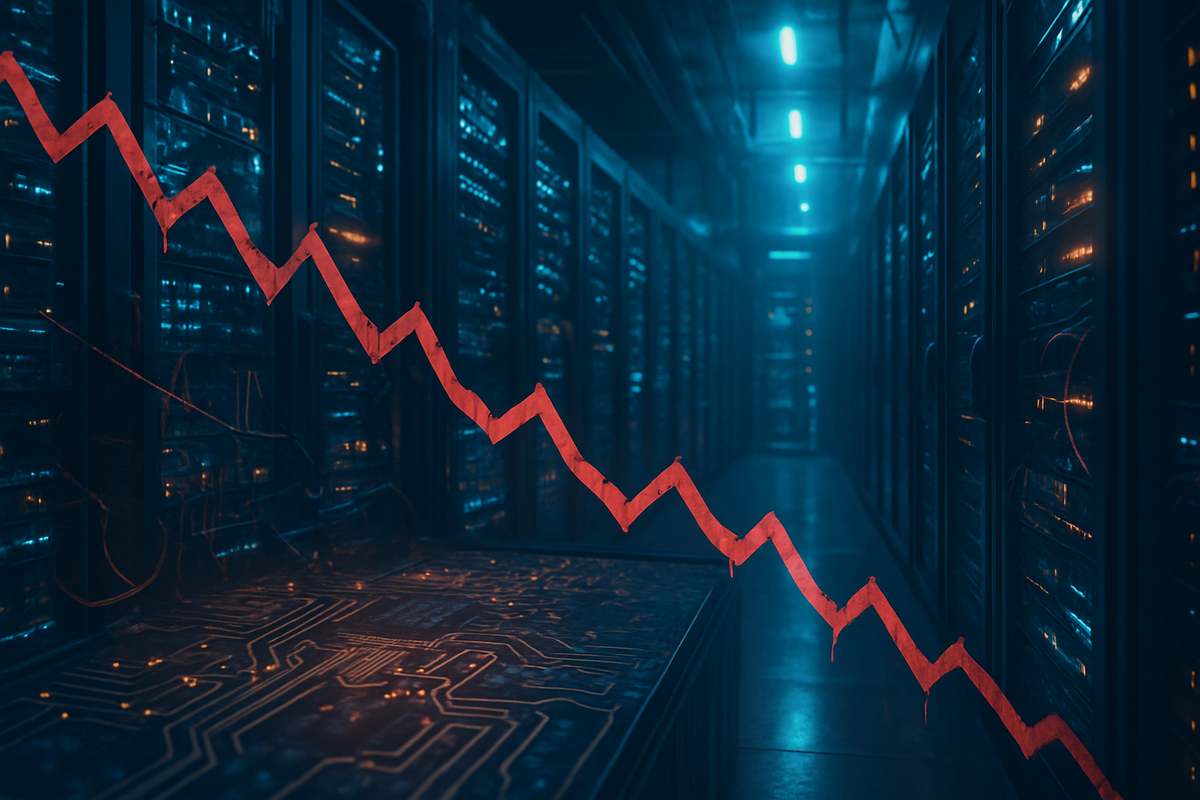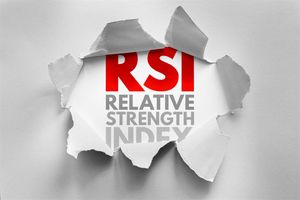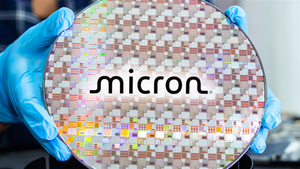
Hyperscale Data (NYSE: GPUS) finds itself at a critical juncture, navigating a complex landscape marked by the routine declaration of preferred stock dividends, a precipitous drop in its common share price, and an ambitious strategic pivot towards the burgeoning fields of artificial intelligence infrastructure and data center operations. As of October 17, 2025, the company's dual announcements underscore a company in transition, attempting to re-engineer its core business while grappling with significant financial headwinds and a skeptical market.
The declaration of monthly cash dividends for its Series D and Series E preferred stock offers a measure of stability for preferred shareholders, yet it stands in stark contrast to the dramatic decline of its common stock. This dichotomy highlights the delicate balance Hyperscale Data is attempting to strike: honoring its commitments to certain investors while aggressively pursuing a high-growth, capital-intensive new direction. The market's immediate reaction, characterized by continued common stock volatility, suggests investors are closely scrutinizing the company's ability to execute this pivot amidst its current financial fragility.
A Company in Flux: Dividends, Decline, and a Definitive AI Shift
Hyperscale Data's recent activities paint a vivid picture of a company undergoing profound transformation. On October 17, 2025, the company declared its monthly cash dividends, with shareholders of the 13.00% Series D Cumulative Redeemable Perpetual Preferred Stock set to receive $0.2708333 per share, and holders of the 10.00% Series E Cumulative Redeemable Perpetual Preferred Stock receiving $0.20833 per share. These payments, scheduled for November 10, 2025, with a record date of October 31, 2025, mark a continuation of consistent preferred dividend payments, with the Series D having completed 36 consecutive monthly payments as of July 2025. This commitment to preferred shareholders provides a necessary anchor amidst broader market turbulence.
However, the stability offered by these preferred dividends is overshadowed by the alarming performance of Hyperscale Data's common stock (NYSE: GPUS). The stock experienced a 5.7% decline on October 16, 2025, closing at $0.3635, and has seen a staggering 24.90% decrease over the preceding ten days. This recent slump follows a pattern of extreme volatility, including an approximate 10.1% intraday drop around October 9, 2025, despite the company announcing a $30 million reduction in non-affiliated consolidated debt. Over the past year, the common stock has plummeted by more than 95%, wiping out significant shareholder value. A key event contributing to this volatility was a special one-time dividend of 20 million shares of Class B Common Stock announced in September 2025, with a record date of October 6, 2025. Such distributions often lead to price adjustments, and market discussions prior to October 6th anticipated a stock crash, reflecting historical trends where similar payouts result in prices dropping below pre-announcement levels. Analyst sentiment, including TipRanks' AI Analyst "Spark," rates GPUS as "Neutral" due to poor financial performance, negative profitability, and high leverage, with a recent "Hold" rating and a price target of $0.50 as of October 9, 2025.
Central to Hyperscale Data's narrative is its aggressive strategic pivot to become a pure-play artificial intelligence infrastructure and digital asset company. This involves the planned divestiture of its subsidiary, Ault Capital Group (ACG), which is expected to finalize in the second quarter of 2026. Post-divestiture, the company will focus exclusively on data center operations and digital asset holdings. Its subsidiary, Sentinum, Inc., is spearheading this shift, operating a data center in Michigan that provides colocation and hosting services for AI ecosystems while also engaging in digital asset mining. Hyperscale Data is actively converting portions of this facility to support advanced AI solutions and plans to expand its capacity from 30MW to 70MW over the next 20 months, with further potential to reach 340MW to accommodate high-performance computing and AI workloads. This strategic repositioning also includes a revised digital asset strategy to retain all mined Bitcoin and build positions in XRP, with its Bitcoin treasury growing to approximately $54 million as of October 14, 2025, representing 59% of its market capitalization. Recent operational enhancements include orders for 2,000 Bitmain Antminer S21+ units to boost mining efficiency.
The immediate implications are clear: Hyperscale Data is an ambitious company facing significant financial challenges. While the preferred dividends maintain investor confidence for a segment, the common stock's performance underscores deep investor concerns about the company's balance sheet. Financial assessments from InvestingPro and GuruFocus rate its health as "weak" or "poor," citing $114.09 million in debt, a current ratio of 0.31, persistent negative profitability, and a high debt-to-equity ratio of 20.7. An Altman Z-Score of -5.22 places it firmly in the "distress zone," signaling potential bankruptcy risk within two years, despite projected 2025 revenues between $125 million and $135 million. The market is weighing the significant long-term potential of the AI and data center markets against the immediate execution risks and the company's strained financial position.
Market Ripples: Identifying Winners and Losers in Hyperscale Data's Pivot
Hyperscale Data's (NYSE: GPUS) strategic pivot into AI infrastructure and data center operations, while fraught with its own financial challenges, is unfolding within an explosively growing market. This shift creates a clear delineation of potential winners and losers, both directly related to GPUS and within the broader technology ecosystem.
The most immediate and significant beneficiaries of the surging demand for AI infrastructure are the core technology providers. NVIDIA (NASDAQ: NVDA) stands out as the paramount winner, dominating the data center GPU market with a staggering 92% share. Its Blackwell architecture and forthcoming Vera/Rubin CPUs are indispensable for advanced AI training and inference, ensuring NVIDIA's central role in every major AI deployment. Similarly, networking and interconnect providers like Arista Networks (NYSE: ANET) and Broadcom (NASDAQ: AVGO) are critical. Arista's high-end switches facilitate the massive data flows required by AI clusters, while Broadcom's custom XPUs are integral to large-scale AI environments, with both companies experiencing robust earnings growth. Hyperscale cloud providers such as Microsoft (NASDAQ: MSFT), Amazon (NASDAQ: AMZN), Google (NASDAQ: GOOGL), and Oracle (NYSE: ORCL) are also making multi-billion dollar investments, deploying advanced cooling and modular data center designs to scale their AI capabilities.
Beyond the chip and network giants, pure-play data center operators are experiencing a boom. Companies like Equinix (NASDAQ: EQIX), Digital Realty (NYSE: DLR), Applied Digital (NASDAQ: APLD), Nebius Group, and Iris Energy (NASDAQ: IREN) are rapidly expanding their footprints to accommodate AI workloads, which demand significantly higher power density and specialized cooling solutions. Applied Digital, for instance, has secured an $11 billion leasing contract with CoreWeave, underscoring the immense demand. Electrical equipment and infrastructure suppliers, including Legrand (EPA: LR) and Schneider Electric (EPA: SU), are also poised for substantial gains as U.S. data center capacity is projected to triple due to AI. Other chipmakers like Intel (NASDAQ: INTC) and AMD (NASDAQ: AMD) are also making concerted efforts in the AI space with new chips and strategic partnerships, while High Bandwidth Memory (HBM) suppliers such as SK Hynix (KRX: 000660), Samsung (KRX: 005930), and Micron (NASDAQ: MU) are crucial as HBM is essential for high-performance computing in AI.
On the other side of the coin, several entities face potential challenges or losses. Foremost among them are Hyperscale Data (NYSE: GPUS) investors in the common stock. Despite the strategic pivot, the company's precarious financial health—marked by high debt, liquidity issues, negative profitability, and a distressed Altman Z-Score—presents significant risks. The over 95% stock decline in the past year reflects deep investor skepticism regarding the successful execution of its ambitious AI transformation. The planned divestiture of Ault Capital Group, Inc. (ACG), Hyperscale Data's non-data center subsidiary, could also create uncertainty for ACG's diverse businesses and stakeholders, depending on the terms and execution of the separation. Furthermore, any partners or operations exclusively tied to Hyperscale Data's pre-pivot, single-purpose blockchain mining or other non-AI-related ventures may face reduced investment or diminished strategic importance as GPUS reallocates its resources. The intense demand for high-performance GPUs from large-scale AI data centers, including those built by companies like Hyperscale Data, also contributes to global GPU shortages and inflated prices, negatively impacting smaller businesses and individual consumers who rely on these components for gaming, content creation, or small-scale AI development. Finally, traditional data center operators that are not equipped to handle the high power density, advanced cooling, and specialized infrastructure required for AI workloads may struggle to remain competitive or attract the lucrative AI-focused clientele, potentially losing market share to more specialized players.
A Microcosm of Macro Trends: Broader Implications of Hyperscale Data's Transformation
Hyperscale Data's (NYSE: GPUS) bold pivot towards AI infrastructure and data center operations, even amidst its precarious financial state, serves as a compelling microcosm of broader, transformative trends sweeping across the technology and financial sectors. This strategic realignment is not merely a corporate decision but a reflection of a global race for AI dominance, with significant ripple effects across industries, regulatory landscapes, and historical business precedents.
At its core, Hyperscale Data's shift aligns with the unprecedented surge in demand for AI-driven computing power. The AI data center market is experiencing explosive growth, projected to expand at a Compound Annual Growth Rate (CAGR) of 28.3% through 2030. By 2025, an estimated 33% of global data center capacity will be dedicated to AI, a figure expected to reach 70% by 2030. This monumental shift is driven by the insatiable appetite for AI workloads, which demand significantly higher power densities—projected to reach 60-120 kW per rack, and potentially 250 kW, in the near future—and necessitate advanced cooling solutions like liquid cooling. Trillion-dollar investments from tech titans like Microsoft (NASDAQ: MSFT) and Amazon (NASDAQ: AMZN) underscore the scale of this transition, highlighting a global scramble for AI-ready infrastructure. Hyperscale Data's plan to convert its Michigan facility to support NVIDIA Blackwell systems and significantly expand its power capacity from 28 MW to a long-term goal of 340 MW directly taps into this fundamental industry trend, positioning it within a high-growth, albeit highly competitive, segment.
The ripple effects of this industry-wide pivot, exemplified by Hyperscale Data's actions, are profound. For competitors in the data center space, it intensifies the race to provide AI-optimized infrastructure. Companies that fail to invest in high-density racks, advanced cooling, and robust power solutions risk losing market share to more agile players. Even established data center landlords like Digital Realty (NYSE: DLR) and Equinix (NASDAQ: EQIX) are adapting by integrating comprehensive power solutions into their offerings. On the partner front, companies like NVIDIA (NASDAQ: NVDA) are indispensable, with Hyperscale Data's explicit adoption of Blackwell systems further cementing NVIDIA's dominance. Suppliers of high-density hardware, advanced cooling technologies, and specialized power generation equipment stand to benefit immensely. The escalating demand for power also places immense pressure on utility companies, necessitating substantial grid upgrades and creating opportunities for innovative energy solution providers. The dual focus on Bitcoin and AI also means that partners in the cryptocurrency mining space remain relevant for Hyperscale Data, albeit with a shifting emphasis.
Regulatory and policy implications are rapidly emerging as the AI data center boom collides with existing frameworks. The sheer energy consumption of AI data centers, which could triple overall data center energy consumption by 2030, is creating significant strain on local and regional energy grids. This necessitates substantial infrastructure investment and raises questions about sustainable energy sourcing. Policymakers are facing the delicate task of fostering AI innovation while mitigating its environmental footprint. There's a growing push to streamline regulatory barriers, including environmental reviews, zoning restrictions, and permitting delays, which can significantly impede data center construction. Furthermore, while the European AI Act has set a global precedent for ethical AI, specific provisions to mitigate the environmental impact of data centers are still evolving, signaling a potential future landscape of efficiency standards and carbon reporting requirements. The processing of vast amounts of sensitive data within these centers also amplifies the criticality of data privacy and security compliance.
Historically, corporate transformations driven by technological shifts and financial pressures are a recurring motif in business. The broader concept of "digital transformation" has been ongoing since the 1970s, with companies like Netflix (NASDAQ: NFLX) successfully pivoting from DVD rentals to streaming, and Square (NYSE: SQ) revolutionizing mobile payments. These examples highlight how adaptability to technological disruption is paramount for survival and growth. Even within the semiconductor industry, Intel (NASDAQ: INTC), facing market share erosion in traditional CPU markets, has announced significant investments and pivots into AI data center chips to compete with rivals. Hyperscale Data's current trajectory, while unique in its specific challenges and focus, echoes these historical narratives of companies attempting to reinvent themselves to capitalize on the next wave of technological innovation, underscoring the high stakes involved in such ambitious strategic shifts.
The Road Ahead: Navigating Opportunities and Perils in the AI Frontier
Hyperscale Data's (NYSE: GPUS) strategic pivot into the AI data center market places it squarely in a sector brimming with both unprecedented opportunities and formidable challenges. As of October 17, 2025, the short-term horizon (2025-2027) is defined by an insatiable demand for GPUs and specialized AI infrastructure, while the long-term outlook (2028 and beyond) portends a complete redefinition of data center landscapes, dominated by AI workloads and grappling with massive power consumption.
In the short term, the AI infrastructure market is experiencing exponential growth, projected to reach between $74 billion and $87.6 billion in 2025, with some forecasts envisioning nearly $500 billion by 2034. The demand for Graphics Processing Units (GPUs) remains exceptionally strong, with hyperscale cloud operators reporting that GPU instance demand outpaces CPU-provisioned compute by more than twofold. This is driven by the computational intensity of AI models, particularly large language models (LLMs) and generative AI systems. Major tech companies like Microsoft (NASDAQ: MSFT), Amazon (NASDAQ: AMZN), Google (NASDAQ: GOOGL), and Meta (NASDAQ: META) are pouring hundreds of billions into AI data centers, fueling a construction boom. However, this boom comes with intensifying power and cooling challenges, as AI workloads demand significantly more power per rack (projected to reach 130 kW, potentially 250 kW), making traditional air cooling obsolete and accelerating the adoption of liquid cooling systems, which are expected in over 35% of AI-centric data centers by 2025. This tightening supply-demand balance, with data center occupancy rates projected to exceed 95% by late 2026, signals a lucrative but demanding environment for Hyperscale Data.
Looking further ahead, by around 2030, an estimated 70% of data center capacity will need to support advanced AI workloads, with generative AI driving approximately 40% of this demand. This will lead to a massive increase in power consumption, potentially doubling global data center electricity use by 2030, equivalent to Japan's entire electricity consumption today. The market will also see continuous evolution in hardware and architectures, with specialized tensor cores, high-bandwidth memory, and advanced interconnects becoming standard. The adoption of 21-inch Open Rack Enclosures is expected to dominate, driven by the space and cooling requirements of AI servers. Furthermore, the expansion of edge AI and hybrid/multi-cloud deployments will necessitate a proliferation of edge data centers for low-latency applications, creating new avenues for growth and specialization.
For Hyperscale Data (NYSE: GPUS), navigating this future requires several critical strategic pivots and adaptations. First, specialization in AI-optimized infrastructure is paramount, demanding investment in advanced liquid cooling solutions and high-density facilities. Second, securing reliable, high-capacity power and suitable land is the single most critical bottleneck. This necessitates strategic partnerships with energy providers, potentially investment in on-site generation, and careful site selection. Third, offering flexible and scalable service models, such as GPU rental or AI-as-a-Service, can provide crucial revenue streams and attract enterprises. Fourth, strategic partnerships and ecosystem integration with GPU manufacturers like NVIDIA (NASDAQ: NVDA), cloud providers, and other tech partners are essential for access to cutting-edge hardware and market channels. Fifth, a strong focus on energy efficiency and sustainability will be crucial not only for environmental responsibility but also as a cost-saving measure and competitive differentiator. Finally, operational excellence, automation, and talent acquisition in specialized AI and high-performance computing fields will be vital for efficient management and innovation.
Potential scenarios for Hyperscale Data range from a successful turnaround to potential failure. In an optimistic scenario, the company successfully executes its pivot by securing significant capital, forming key partnerships, and specializing in a niche within the AI data center market (e.g., high-density liquid-cooled facilities). This could lead to re-established financial stability and strong growth by late 2026/early 2027. A more likely scenario might see the company achieve moderate growth, making a partial pivot but struggling with intense capital demands, power bottlenecks, and fierce competition. It might survive as a smaller player, potentially becoming an acquisition target. The worst-case scenario involves financial struggles exacerbating, failure to secure sufficient funding, or inability to keep pace with technological advancements, leading to further distress, asset sales, or even bankruptcy. The high capital expenditures and rapid depreciation of AI-specific hardware, where new AI data centers built in 2025 could suffer $40 billion in annual depreciation while generating only $15-$20 billion in revenue, underscore the immense risks. The future for Hyperscale Data hinges on its ability to execute a highly strategic, capital-efficient, and technologically adept pivot to address the unique challenges of this demanding and rapidly evolving sector.
Conclusion: A High-Stakes Gamble in the AI Era
Hyperscale Data's (NYSE: GPUS) declaration of preferred stock dividends, set against the backdrop of a plummeting common stock and an aggressive pivot towards AI and data center operations, epitomizes the high-stakes environment of modern financial markets. The company is attempting to leverage its existing physical assets and expertise to capitalize on the explosive growth of AI infrastructure, a market that promises unprecedented opportunities but also demands immense capital, specialized technology, and flawless execution.
The key takeaways from this unfolding narrative are clear: while preferred shareholders receive a measure of stability, common shareholders face extreme volatility and uncertainty. The strategic shift aligns with undeniable industry trends towards AI-driven computing, positioning Hyperscale Data within a lucrative sector. However, its significant debt, liquidity issues, and negative profitability present formidable obstacles to realizing this potential. The broader market will continue to see immense investment in AI infrastructure, benefiting chipmakers like NVIDIA (NASDAQ: NVDA), networking giants, and specialized data center operators. Conversely, companies unable to adapt to the demanding requirements of AI workloads, or those facing severe financial constraints, risk being left behind.
Moving forward, investors should closely watch Hyperscale Data's ability to secure additional capital, execute its planned divestiture of Ault Capital Group, and most critically, demonstrate tangible progress in converting and expanding its Michigan data center for AI workloads. Success will hinge on its capacity to manage power infrastructure, implement advanced cooling solutions, navigate supply chain complexities, and attract strategic partners. The market will be looking for clear signs of operational efficiency, debt reduction, and a pathway to sustainable profitability in this capital-intensive new direction. The coming months will be pivotal in determining whether Hyperscale Data can transform its ambitious vision into a viable reality, or if its bold gamble in the AI era will further exacerbate its current struggles.
This content is intended for informational purposes only and is not financial advice








